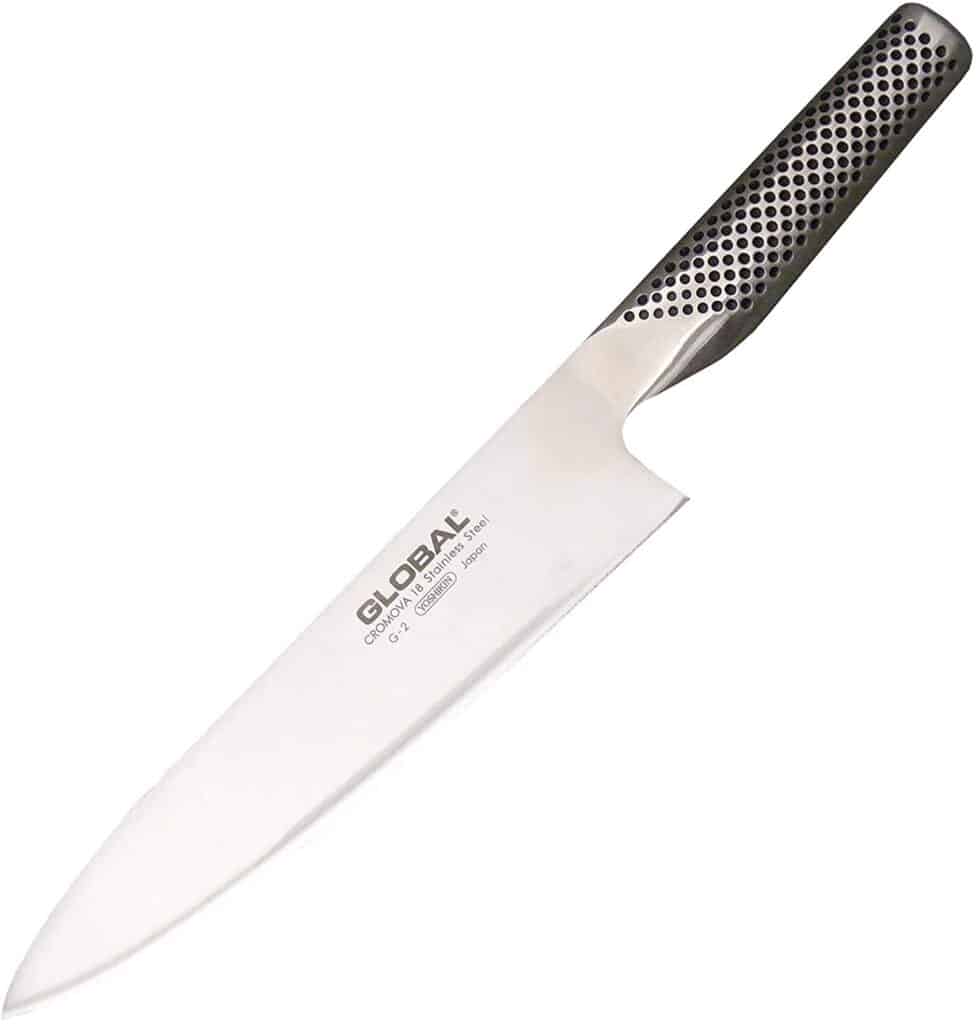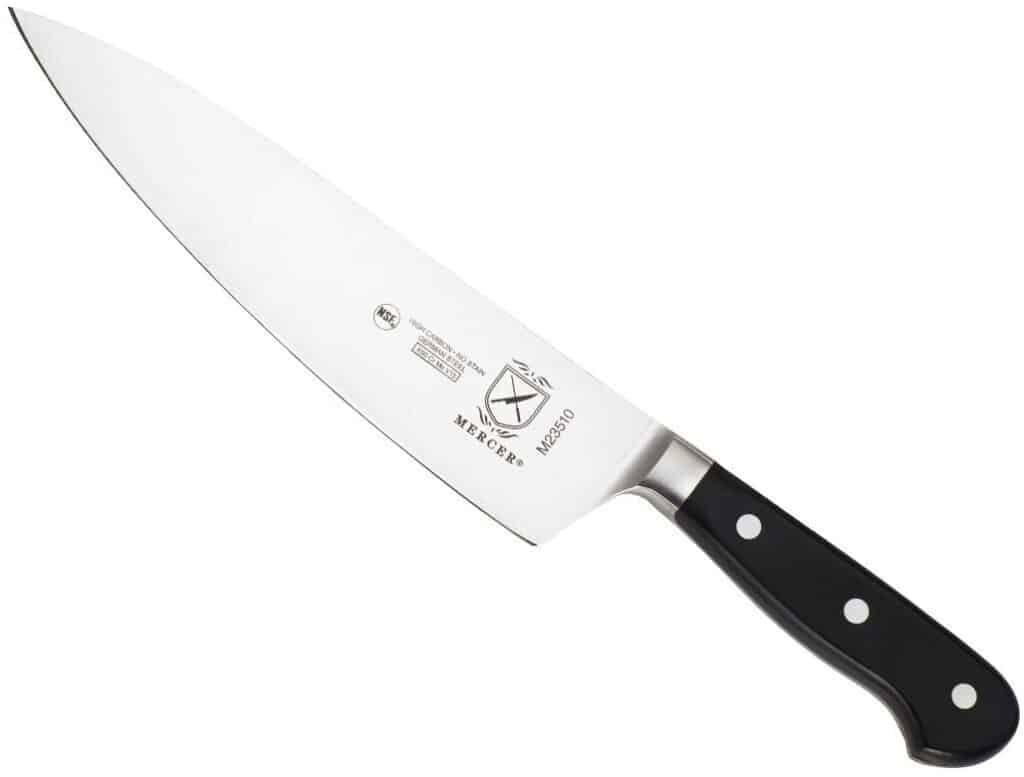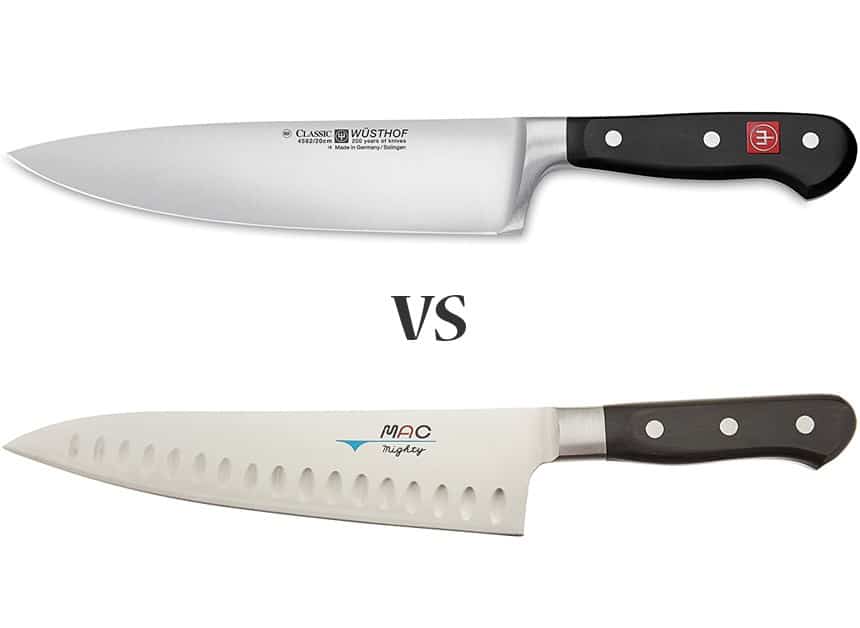
When you start looking into the wide choice of kitchen knife brands you’ll quickly realize they come in a range of different price brackets.
One brand at the lower end of the price scale is Mercer, whilst the Japanese brand Global offers knives at a medium price point.
As a result, many people are often trying to understand the difference between these brands to see what’s right for them and whether it’s worth paying more.
In this article, I’m going to tell you the differences between these two great brands. I’ll go in-depth into the details of each, talking about where they are made, what materials are used and the difference in price.
This should be all the information you need to select your perfect knife.
If you ignore the price and focus on quality, Global knives are unarguably better. They are built for extreme durability, slim and lightweight. However; that is reflected in the price and you can still get a quality knife from Mercer for half the price of a standard Global. If you’re on a budget then Mercer offers some of the best value knives around.
| My recommendation | Current price |
| Mac Professional 8-Inch | View on Amazon (opens new tab) |
| Mercer Culinary Renaissance 8-Inch | View on Amazon (opens new tab) |
Global vs Mercer – Comparison Table
Here is my summary comparison table for each brand. This is mostly based on their main range of knives; the Global Classic (G Series) and the Mercer Renaissance Chef’s Knife.
For a more in-depth look at each category then check out the rest of the article below.
| Category | Global | Mercer |
| Country of Manufacture | Japan | Taiwan |
| Steel type | Chromova18 | X50CrMoV15 |
| Rockwell hardness | HRC 56-58 | HRC 56-58 |
| Factory edge | 15 degrees (double bevel) | 15 degrees (double bevel) |
| Handle material | Steel | POM (thermoplastic) |
| Price range | $150 – $170 (Classic/G Series) | $50 – $60 (Renaissance) |
| Main benefit | Very durable, lightweight and slim | Low price, well designed |
| My recommendation | Global 8-Inch Classic (view on Amazon) | Mercer Renaissance Chef’s Knife 8-Inch (View on Amazon) |
Global vs Mercer – Where are they made
| Brand | Country of manufacture |
| Global | Japan |
| Mercer | Taiwan |
Global knives are manufactured in the city of Niigata, on the North-Western coast of Japan.
Niigata is where the Yoshikin metal manufacturing company has been based since 1954, so they have a good span of heritage making Japanese steels.
Both of these brands produce their knives in the homeland of their heritage, an added bonus for anyone looking for a genuine German or Japanese knife.
Mercer manufactures their knives in Taiwan, using imported German steel.
Mercer is part of a growing trend in the knife industry of using quality materials, like German or Japanese steel, but basing the manufacture in low cost countries, like China or, in Mercer’s case, Taiwan.
In the past these less authentic brands have been of noticeably lower quality, but more and more these brands are actually producing knives of a comparable standard to their German or Japanese counterparts, for a much lower price.
Global is clearly ‘the real deal’ in regard to being a truly Japanese manufacturer, whereas Mercer is a less authentic brand without nearly the same level of heritage.
Global vs Mercer – What steel do they use
Knowing which steel a knife is made of is one of the most important things to understand when buying a knife.
The steel used will give you a very good indication of what the manufacturer has focused on as the most important aspect of the knife, such as durability or sharpness.
| Brand | Steel type | Rockwell hardness |
| Global | Chromova18 | HRC 56 – 58 |
| Mercer Renaissance | X50CrMoV15 | HRC 56-58 |
Global knives are made from their own specially formulated steel, Chromova18.
You’ll only find Chromova18 in Global knives and it’s a very unique steel. To understand why let’s look at some of its Chromium content.
The 18 in Chromova18, represents the steel’s Chromium content, which is 18%. That is a huge level of Chromium by any standard and it’s an amount you’ll rarely see in another knife.
That means that Global knives are especially resistant to rust, making them particularly durable. That’s really the theme of Global knives, they are Japanese knives but they have a focus on durability.
The Carbon content is quite high at 0.75 – 1.05%. Usually, that would lead to a very hard knife, which could hold a super-sharp Japanese style edge, but that’s not the case with Global.
The rather unique composition of Chromova18 actually results in a rather soft steel, with a Rockwell hardness between 56-58 HRC.
I don’t regard this as a bad thing though, it plays directly to the strengths that the brand wants from their knives; durability over sharpness.
A softer steel is less likely to chip and snap, and it’s easier to sharpen (although you would need to sharpen it more often).
Combine that with the 18% Chromium content and this is a knife that will last a very long time.
Mercer knives use a German steel called X50CrMoV15.
It’s popular steel amongst producers of quality western-style knives. That’s because it has a particular focus on durability, whilst retaining enough strength for a sharp edge.
The main elements of interest within X50CrMoV15’s composition are Carbon, Vanadium and Chromium.
The Carbon content is 0.55%. That’s not particularly high when comparing it with other quality knives; however, it’s high enough to provide sufficient strength in the blade for a 15 – 20 degree angle on each side, which is standard for western knives.
The big benefit of not having a very high Carbon content is that higher Carbon steels are usually more brittle, therefore the 0.55% content keeps the blade durable.
That’s the same with the strong Vanadium of 0.4%, Vanadium improves the resistance to wear of the steel also adding to its durability.
The Chromium content is 15% is what the 15 in X50CrMoV15 represents. Chromium is vital for the durability of steel as it’s what makes stainless steel resistant to rust.
Steel need only be 10.5% to be considered stainless, so a 15% content is high and makes this a quality stainless steel, very unlikely to rust unless extremely mistreated by the owner.
Both brands use a steel that is focused more on durability than sharpness, that’s reflected in the relatively low HRC rating they have, a rating which measures hardness.
That means they will be unlikely to crack and chip and easy to sharpen, but they will not hold a sharp edge for as long as a harder steel and will need to be sharpened frequently to retain it.
Global vs Mercer – How sharp are they
Once again I’m going to focus on the most popular knives from each brand for this comparison.
Global knives are a little sharper than Mercer due to the straighter bevel of the cutting edge. They use steel of very similar hardness so will retain their edges for a similar length of time.
| Brand | Factory edge | Rockwell hardness |
| Global | 15 degrees (double bevel with straighter edge) | HRC 56-58 |
| Mercer Renaissance | 15 degrees (double bevel) | HRC 56-58 |
Mercer uses a standard bevel for their edge, whereas Global uses the more Japanese straight bevel. Effectively the edge angle on a Global will continue up the blade for some way, whereas the cutting angle on the Mercer is very close to the cutting edge.
Global knives use a different style of bevel for their knives, which should make them sharper straight out of the factory.
The steel used for both knives is of very similar hardness, so they will be quite equal in edge retention.
As a result, there isn’t a huge amount between the two when measuring sharpness.
They will both certainly be sharp enough, but neither of them offers the super sharp edge of high-Carbon Japanese knives as they both focus more on durability.
Overall though, the Global has a slightly sharper edge than Mercer.
Global vs Mercer – What are the handles made from
The material used for handles is a vital and often overlooked feature of any knife.
A quality handle is often the sign of a quality overall knife. Handles need to be made from a durable material that can withstand all the heat and moisture fluctuations knives can experience in the kitchen.
| Brand | Handle material |
| Global | Chromova18 steel |
| Mercer Renaissance | POM (thermoplastic) |
Global knives use their own steel, Chromova18 to create the handle, and form the whole knife out of a seemingly single piece of steel.
Technically the knife isn’t made from one piece of steel. The blade is made in one piece. The handle is made from a further two pieces, the handle is hollow and filled with sand in order to offer the perfect counterbalance weight to the blade.
All the pieces are then welded together to form a seamless knife, with the blade and handle becoming one.
It’s a fantastic design and results in the most durable handle you’ll find in any knife, it’s basically impossible to damage this handle unless you were pretty determined to.
As the stainless steel on its own would be difficult to grip, Global handles are always dimpled to provide extra friction. It’s a technique that works well and for home use, providing the cook with plenty of control over the knife.
Global handles are near indestructible and contribute drastically to the lightweight design of Global knives due to the hollowed handle.
Mercer use a thermoplastic material called POM (Polyoxymethylene) for their knife handles.
Materials like these are ideal for knife handles due to their extreme durability.
POM is specifically designed for high stiffness and stability, and being a thermoplastic means it’s also extremely resistant to temperature and moisture changes.
Both the POM and continuous steel are fantastic handle options, you won’t be able to damage a Global handle in normal use, and it’ll be pretty hard to damage a Mercer handle too.
But for pure indestructibility, Global wins.
Global vs Mercer – How much do they cost
Both these brands have wide ranges of knives all at differing price ranges.
To allow for a fairer comparison I’ve categorized three of their major ranges that represent their highest and lowest cost knives.
I’ve tried to compare similar knives, sticking to 8 Inch Chef’s knives or the closest equivalent.
In brackets next to the general price range you’ll see the name of the range.
These prices are rough estimates. Prices do change over time but this is intended as a rough guide.
| Brand range | Global | Mercer |
| Premium | $200 – $250 (SAI) | Not Applicable |
| Standard | $150 – $170 (Classic/G Series) | $50 – $60 (Renaissance) |
| Value | No value range (although often discounted) | $15 – $25 (Millennia) |
What is clear is that these two brands offer their knives at very different price ranges.
Mercer is a brand that generally lies at the budget end of the price scale. That’s fine if it’s what you’re looking for. Mercer makes a really quality knife for what you pay.
However; the clear superiority of Global knives shows in their price.
The steel they use is superb whilst still remaining light and slim and the general build quality of Global knives is on another level to the more budget Mercer.
Global vs Mercer – What is the difference
Now that we have looked at the design, materials, background and price of these brands we can fully understand the difference, and you should be able to make an informed decision on which knife is correct for you.
The main difference between Global and Mercer knives is the overall quality. Global use a slightly better steel, with a slightly sharper edge, whilst remaining lightweight and slim. But Mercer knives cost significantly less and still offer very good value for money.
| Brand | Main benefit |
| Global | Very durable, lightweight and slim |
| Mercer | Low price, well designed |
Both these knives have been built for durability, and they are both very successful in achieving that goal.
But Global just provides a slightly better product in every aspect Mercer.
Global knives are much more lightweight and slim. There is no bolster at all and the handle is hollow. The steel is incredibly high quality stainless steel but is still very durable
Global knives are better suited for those with smaller hands because they are so slim and lightweight. That’s especially useful for family kitchens, where many different people might be using the knife.
Both these brands are top quality, and Global knives are very unique, but ultimately the Global is a better knife all round, it just costs quite a bit more.
Global vs Mercer – Which is better for you
This really comes down to what is important to you.
If you’re looking for an all-round great knife that is very durable I would recommend the Global. It’s great for family kitchens where it could easily be left wet after use or soaking in a kitchen sink because the stainless steel quality is so high it’s very unlikely to rust.
It’s also lightweight and slim so can be easily used by a range of different sized people, often useful in a family kitchen.
And it’s authentically Japanese which is something people often find important when paying upwards of $100 for a knife.
If you’re looking for a quality knife that represents very good value for money, the Mercer is a great choice.
Mercer’s Renaissance range offers some of the best value-for-money knives you will find that match very well with higher-priced western chef’s knives like those of ZWILLING and Wusthof.
They will cost around half to a third the price of a Global knife and they are still very good quality.
My Global Recommendation

View the 8-Inch Global Classic on Amazon (opens new tab)
The Global Classic 8-Inch is one of the most durable knives you can find.
It’s made from a 18% Chromium stainless steel that is pretty much un-matched in the knife world.
But its biggest selling point is its size and weight. Global knives are very light and because they are entirely steel, the handle is actually hollow, with just some sand to counterbalance the blade.
It has no bolster and is slimmer than most knives, which makes it perfect for those who want a lighter, easier to control knife and is especially suited for people with smaller hands.
It’s a great knife, and one of a kind.
My Mercer Recommendation

View the 8-Inch Mercer Renaissance Chef’s Knife on Amazon (opens new tab)
This is one of the most expensive knives from Mercer, and it’s still only at the price of most other brands value ranges.
What you get for around $50 is very good value. X50CrMoV15 forged german steel, half bolster with a thermoplastic, triple riveted handle and a classic western chef’s knife design.
It’s a knife you just can’t be disappointed with at that price.
It may not be the genuine article in that it’s manufactured in Taiwan instead of German, but it’s still a quality knife, and an absolute bargain.

